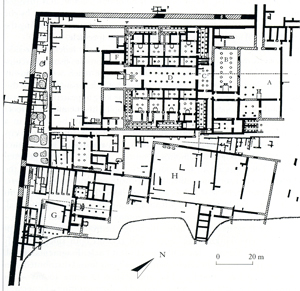The two main cities of ancient Egypt were Memphis and Thebes. Memphis lay near modern Cairo, at the southern tip of the Nile Delta. Thebes lay in Upper Egypt, in the same spot as modern Luxor. Both Memphis and Thebes are the names given by the Greeks to these cities after Alexander the Great conquered Egypt in 332BC. Memphis is the Greek version of the Egyptian Men-nefer ('Established and good'). Thebes however is nothing like the proper Egyptian name, Waset. Thebes is in fact a city in Greece.
Waset, which means the Place of Dominion, was also known by the locals as the City of Amun, or just the City for short - in Egyptian, Iunu. It was a large city, but nowadays only the temples remain. Everything else, even the palaces, was built of mud brick, which has dissolved over the centuries. Farmers have also used the mud bricks for fertiliser. So if you visit Luxor today, you can see the Temple of Karnak, the Temple of Luxor (both of which are temples of Amun), some other minor temples, some sphinxes, and not much else from the ancient times. We know Hatshepsut had a palace somewhere near Karnak, but I have used my writer's imagination to place it where I have.

Reconstruction of Thebes (after Hatshepsut's time)
The city would have been filled with all kinds of structures - houses of rich and poor, workshops, chapels and shrines, warehouses and so on. There was little sanitation and rubbish would have been burnt, thrown in the river, or taken to a general dump. The city would have been quite smelly with all the refuse, and the animals such as cattle, pigs, donkeys, and geese, being driven through the streets. Outbreaks of disease would have been quite common, with little understanding of how to treat them. And yet there is no doubt that ancient Thebes was a colourful, noisy, cheerful place.
 Palaces
Palaces
Egyptian kings had many palaces, not just one. They had a palace at every main stop along the Nile for when they were travelling about the country. And they had different palaces in the main cities like Thebes and Memphis - one for living in, one for religious ceremonies (like the Feast of Horus in chapter 16), and perhaps one attached to their mortuary temple (Ramesses III had one of these). And of course there were government offices too - in my novel Hapuseneb has his own, and Senenmut has one in the same building as the feasting room.
left: throne room in palace of Ramses III

Throne rooms in these palaces are often very small - kings would not want to be surrounded by too many people. They would sit on a raised platform to meet important guests or to make commands or pass judgments. The rooms would be filled with columns and quite claustrophobic. The palace walls and floors might be nicely decorated - Akhenaten's palace had lots of colourful tiles (like those in Senenmut's office) and paintings of ducks in papyrus and the like.
right: map of palace of Amenhotep III
centred around the hall of columns, D

Hapuseneb and Puyemre
Hapuseneb and Puyemre were real historical figures. Hapuseneb's name (see above) means 'healthy oar' (I think...). He was the first prophet of Amun, also known as the high priest - that is, the most important priest in the country. He was the designer of Hatshepsut's tomb, KV20, or rather of the extra rooms added to her father's tomb. His own tomb, which we call TT67, was in Thebes.
Puyemre was second prophet of Amun, in other words Hapuseneb's second in command. He was in charge of the production of ritual objects for the temples. He also had a role in building Djeser Djeseru. Although he was a real person, everything he does in my story is made up. Also he was married to Hapuseneb's daughter, Seniseneb, which I conveniently ignored.
His name, as far as I can make out, means 'That with Re'. (Re is the sun god). He was buried in tomb TT39 in Thebes.